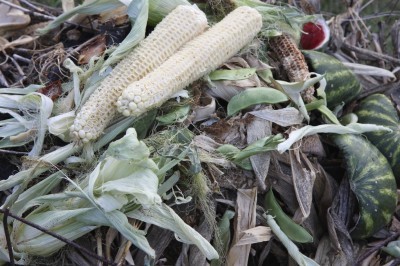






Composting corn cobs and husks is a sustainable process of turning garbage-bound kitchen leftovers into garden-rich nutrients for your plants. You can also use other discarded parts of the corn plant in your compost pile, such as the stalks, leaves and even the corn silks. Read on for tips on composting these items successfully.
The husks – these form the outer layer that protects the developing corn – are discarded when you peel them away to expose the corn kernels. Instead of tossing them in the trash, simply toss them in your compost pile.
For composting corn husks, you can use green husks, which are removed before eating fresh corn, or brown husks, which are left intact around ears of corn to be used for harvesting seed or feeding livestock.
Yes, you can! Although composting a corn cob takes longer than composting corn husks, the cobs serve an additional purpose even before they decompose into useable compost. Left intact, corn cobs provide air pockets in a compost pile.
These air pockets help speed up the decomposition process so your compost is ready to use quicker than it would be from an oxygen-deprived pile.
Open or Enclosed. For composting corn cobs and husks, as well as other parts of the corn plant and other organic matter, you can use an open compost pile or you can build a frame to keep the contents enclosed. Your frame can be made of wire mesh, concrete blocks or wooden pallets, but be sure to leave the bottom open so the compost drains well.
Ratio Recipe. Keep a 4:1 ratio of “brown” to “green” ingredients so your compost pile doesn’t become soggy, which can cause an offensive odor. For example, when composting corn cobs and husks, the “greener” the ingredients, the more moisture they’ll contribute. “Brown” includes dried plant parts, and “green” refers to the still-moist and freshly cut or shucked parts. Tip: The moisture content of your compost pile should ideally be 40 percent – as moist as a lightly dampened sponge.
Size of Materials. Simply put, the larger the pieces, the longer it takes them to degrade into compost. When you’re composting a corn cob, they’ll decompose more rapidly if you cut them into smaller pieces. For composting corn husks, you can shred them into smaller pieces by mowing over them, or you can leave them whole.
Turning the Pile. Turning a compost pile moves air inside it and hastens decomposition. Use a spading fork or shovel to lift and turn the compost at least a month.
Finished compost is dark brown and crumbly, with no foul odor. There should be no recognizable pieces of organic matter. Because composting corn cobs takes longer than composting other parts of the corn plant, you may still see some bits of cobs left after the other organic matter has sufficiently broken down. You can remove these cobs, use the finished compost and toss the cobs back into the compost pile.
Composting Fish Waste: Tips On How To Compost Fish Scraps
Composting Tomato Plants: When To Compost Tomatoes
Using Seaweed For Compost: Learn How To Compost Seaweed
Composting Gin Trash – How To Compost Cotton Gin Trash
Composting Tomato Plants: When To Compost Tomatoes
Composting And Dining Sustainability
Kitchen Composting: How To Compost Food Scraps From The Kitchen
Can You Compost Diapers: Learn About Composting Diapers At Home
Composting Leaves In Garden: Learn The Benefits Of Leaf Compost
Kitchen Composting: How To Compost Food Scraps From The Kitchen
Copyright © www.100flowers.win Botanic Garden All Rights Reserved